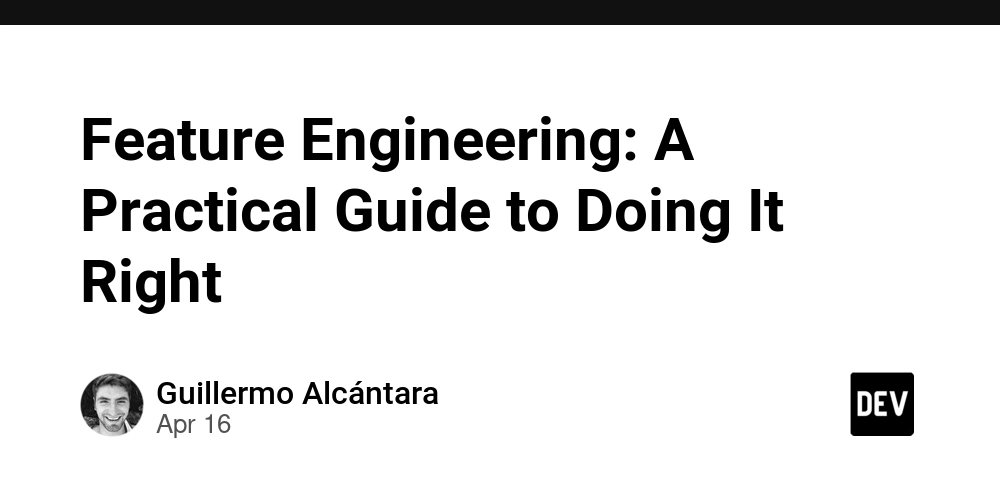Feature Engineering: A Practical Guide to Doing It Right
Introduction You’ve probably heard it a hundred times: feature engineering is the key to unlocking better model performance. But what does that actually mean? And more importantly—where do you start? If you’re staring at a dataset and feeling unsure what to do with it, you’re not alone. Maybe it’s a mix of numbers, categories, and even some free-form text. Maybe you’ve already thrown it into a model and gotten “meh” results. And now you’re wondering: am I missing something obvious? Here’s the thing—most people jump straight into feature engineering without really understanding their data. That’s like trying to decorate a house before it’s even built. To do this well, you need a framework. One that helps you identify the type of data you’re working with, choose the right techniques, and measure whether what you’re doing is actually making a difference. This article breaks it all down for you. You’ll learn the core principles behind feature engineering, including: The difference between structured and unstructured data—and why it matters How to classify features into four key levels (and what you can actually do with them) A clear breakdown of the five main types of feature engineering How to evaluate your work beyond just model accuracy And finally, a repeatable, step-by-step process to do it all with confidence If you're ready to stop guessing and start engineering your features with purpose—this is your blueprint. 1. Structured vs. Unstructured Data Before you apply any feature engineering techniques, you need to understand what kind of data you're working with. Structured data lives in spreadsheets and databases—think rows and columns, like customer age, income, or product ratings. It's neat, easy to query, and easy for machine learning models to parse. Unstructured data includes things like text, images, audio, or video. There’s no predefined format. It makes up roughly 80% of enterprise data, but it’s harder to work with. Most machine learning models need structured input. So, if you’ve got unstructured data, your first task is to transform it—usually through feature extraction or feature learning. Sometimes, datasets are a mix of both. For example, a customer service dataset might include structured fields like time of call, and unstructured fields like call transcripts. The goal is always the same: get it into a structured format your model can understand. 2. The Four Levels of Data Understanding the type of each feature in your dataset is critical because it determines what you can (and can’t) do with it. Here are the four levels: Nominal (Qualitative, No Order) Examples: blood type, product category Only meaningful operations: mode, counts Common technique: convert to binary/dummy variables Ordinal (Qualitative, Ordered) Examples: satisfaction rating, education level Has order, but gaps between values aren’t consistent Strategy: assign integers (e.g. 1–5), but avoid maths on them unless it makes sense Interval (Quantitative, No True Zero) Examples: temperature in Celsius, dates Differences are meaningful, ratios aren’t OK to calculate: mean, standard deviation Avoid: saying “twice as much” (e.g. 100°C ≠ 2× 50°C) Ratio (Quantitative, True Zero) Examples: age, income, weight All arithmetic operations are valid, including ratios You can use arithmetic, geometric, or harmonic means Quick Tip: Misclassifying interval vs. ratio isn’t the end of the world. But mixing up qualitative and quantitative types can break your model logic. 3. The Five Types of Feature Engineering Once you understand your data and its levels, you can start applying the right techniques. Here’s a breakdown of the five main types of feature engineering: 1. Feature Improvement Goal: clean and refine existing features Techniques: fill missing values, scale numbers, normalise distributions When to use: features are noisy, incomplete, or skewed 2. Feature Construction Goal: create new features from existing ones Example: combine "day" and "hour" into "daypart", or map text categories to sentiment scores Requires: domain knowledge and logic When to use: original features lack signal or need transformation 3. Feature Selection Goal: keep only the most relevant features Benefits: reduces overfitting, speeds up models, improves interpretability Techniques: correlation filtering, mutual information, model-based selection When to use: high dimensionality, multicollinearity, or slow training times 4. Feature Extraction Goal: reduce dimensionality or summarise unstructured data Techniques: PCA, SVD, Bag-of-Words for text When to use: assumptions about structure are valid, or when simplifying data 5. Feature Learning Goal: let deep models create features from raw data Techniques: autoencoders, CNNs, GANs Powerful, but: needs l

Introduction
You’ve probably heard it a hundred times: feature engineering is the key to unlocking better model performance. But what does that actually mean? And more importantly—where do you start?
If you’re staring at a dataset and feeling unsure what to do with it, you’re not alone. Maybe it’s a mix of numbers, categories, and even some free-form text. Maybe you’ve already thrown it into a model and gotten “meh” results. And now you’re wondering: am I missing something obvious?
Here’s the thing—most people jump straight into feature engineering without really understanding their data. That’s like trying to decorate a house before it’s even built. To do this well, you need a framework. One that helps you identify the type of data you’re working with, choose the right techniques, and measure whether what you’re doing is actually making a difference.
This article breaks it all down for you. You’ll learn the core principles behind feature engineering, including:
- The difference between structured and unstructured data—and why it matters
- How to classify features into four key levels (and what you can actually do with them)
- A clear breakdown of the five main types of feature engineering
- How to evaluate your work beyond just model accuracy
- And finally, a repeatable, step-by-step process to do it all with confidence
If you're ready to stop guessing and start engineering your features with purpose—this is your blueprint.
1. Structured vs. Unstructured Data
Before you apply any feature engineering techniques, you need to understand what kind of data you're working with.
- Structured data lives in spreadsheets and databases—think rows and columns, like customer age, income, or product ratings. It's neat, easy to query, and easy for machine learning models to parse.
- Unstructured data includes things like text, images, audio, or video. There’s no predefined format. It makes up roughly 80% of enterprise data, but it’s harder to work with.
Most machine learning models need structured input. So, if you’ve got unstructured data, your first task is to transform it—usually through feature extraction or feature learning.
Sometimes, datasets are a mix of both. For example, a customer service dataset might include structured fields like time of call, and unstructured fields like call transcripts. The goal is always the same: get it into a structured format your model can understand.
2. The Four Levels of Data
Understanding the type of each feature in your dataset is critical because it determines what you can (and can’t) do with it. Here are the four levels:
Nominal (Qualitative, No Order)
- Examples: blood type, product category
- Only meaningful operations: mode, counts
- Common technique: convert to binary/dummy variables
Ordinal (Qualitative, Ordered)
- Examples: satisfaction rating, education level
- Has order, but gaps between values aren’t consistent
- Strategy: assign integers (e.g. 1–5), but avoid maths on them unless it makes sense
Interval (Quantitative, No True Zero)
- Examples: temperature in Celsius, dates
- Differences are meaningful, ratios aren’t
- OK to calculate: mean, standard deviation
- Avoid: saying “twice as much” (e.g. 100°C ≠ 2× 50°C)
Ratio (Quantitative, True Zero)
- Examples: age, income, weight
- All arithmetic operations are valid, including ratios
- You can use arithmetic, geometric, or harmonic means
Quick Tip:
Misclassifying interval vs. ratio isn’t the end of the world. But mixing up qualitative and quantitative types can break your model logic.
3. The Five Types of Feature Engineering
Once you understand your data and its levels, you can start applying the right techniques. Here’s a breakdown of the five main types of feature engineering:
1. Feature Improvement
- Goal: clean and refine existing features
- Techniques: fill missing values, scale numbers, normalise distributions
- When to use: features are noisy, incomplete, or skewed
2. Feature Construction
- Goal: create new features from existing ones
- Example: combine "day" and "hour" into "daypart", or map text categories to sentiment scores
- Requires: domain knowledge and logic
- When to use: original features lack signal or need transformation
3. Feature Selection
- Goal: keep only the most relevant features
- Benefits: reduces overfitting, speeds up models, improves interpretability
- Techniques: correlation filtering, mutual information, model-based selection
- When to use: high dimensionality, multicollinearity, or slow training times
4. Feature Extraction
- Goal: reduce dimensionality or summarise unstructured data
- Techniques: PCA, SVD, Bag-of-Words for text
- When to use: assumptions about structure are valid, or when simplifying data
5. Feature Learning
- Goal: let deep models create features from raw data
- Techniques: autoencoders, CNNs, GANs
- Powerful, but: needs lots of data, features may be hard to interpret
- Best for: images, audio, text—when manual engineering isn’t feasible
4. How to Evaluate Feature Engineering
Creating new features is one thing—knowing if they actually help is another. Here’s how to assess their impact:
Machine Learning Metrics
- Compare model performance (accuracy, precision, recall) before and after applying techniques
- Look for real gains, not just tiny improvements
Interpretability
- Can you explain what a feature does?
- Human-friendly features help with debugging, stakeholder trust, and regulatory compliance
- Simpler models often win here (e.g. using decision trees instead of deep nets)
Fairness and Bias
- Watch for features that encode bias (e.g. postcode might correlate with race or income)
- Good feature engineering can help reveal and reduce these risks
Speed and Complexity
- Fewer, more informative features usually train faster
- High-dimensional data can slow things down and increase storage/memory needs
5. The Feature Engineering Process
Here’s a repeatable, 5-step process to follow:
-
Structure Your Data
- Convert unstructured data to structured using extraction or learning
-
Classify Feature Types
- Assign each feature a level: nominal, ordinal, interval, or ratio
-
Apply Engineering Techniques
- Choose from the five categories: improve, construct, select, extract, or learn—based on your feature types
-
Evaluate Impact
- Use model performance, interpretability, fairness, and speed as your criteria
-
Iterate
- Based on results, repeat or adjust your techniques
Final Thoughts
Feature engineering isn’t about using every technique under the sun—it’s about using the right ones, for the right data, at the right time. Start by understanding your data. Know its structure. Know its level. And use that knowledge to apply logical, targeted transformations.
When you follow this framework, you stop guessing and start building features that actually move the needle. That’s how you make your models smarter—not just bigger.




























![[Webinar] AI Is Already Inside Your SaaS Stack — Learn How to Prevent the Next Silent Breach](https://blogger.googleusercontent.com/img/b/R29vZ2xl/AVvXsEiOWn65wd33dg2uO99NrtKbpYLfcepwOLidQDMls0HXKlA91k6HURluRA4WXgJRAZldEe1VReMQZyyYt1PgnoAn5JPpILsWlXIzmrBSs_TBoyPwO7hZrWouBg2-O3mdeoeSGY-l9_bsZB7vbpKjTSvG93zNytjxgTaMPqo9iq9Z5pGa05CJOs9uXpwHFT4/s1600/ai-cyber.jpg?#)











































































































































![[The AI Show Episode 144]: ChatGPT’s New Memory, Shopify CEO’s Leaked “AI First” Memo, Google Cloud Next Releases, o3 and o4-mini Coming Soon & Llama 4’s Rocky Launch](https://www.marketingaiinstitute.com/hubfs/ep%20144%20cover.png)





























































































































![[FREE EBOOKS] Machine Learning Hero, AI-Assisted Programming for Web and Machine Learning & Four More Best Selling Titles](https://www.javacodegeeks.com/wp-content/uploads/2012/12/jcg-logo.jpg)








































































![Rogue Company Elite tier list of best characters [April 2025]](https://media.pocketgamer.com/artwork/na-33136-1657102075/rogue-company-ios-android-tier-cover.jpg?#)








































































_Andreas_Prott_Alamy.jpg?width=1280&auto=webp&quality=80&disable=upscale#)





























































































![What’s new in Android’s April 2025 Google System Updates [U: 4/18]](https://i0.wp.com/9to5google.com/wp-content/uploads/sites/4/2025/01/google-play-services-3.jpg?resize=1200%2C628&quality=82&strip=all&ssl=1)










![Apple Watch Series 10 Back On Sale for $299! [Lowest Price Ever]](https://www.iclarified.com/images/news/96657/96657/96657-640.jpg)
![EU Postpones Apple App Store Fines Amid Tariff Negotiations [Report]](https://www.iclarified.com/images/news/97068/97068/97068-640.jpg)
![Apple Slips to Fifth in China's Smartphone Market with 9% Decline [Report]](https://www.iclarified.com/images/news/97065/97065/97065-640.jpg)


































































































































